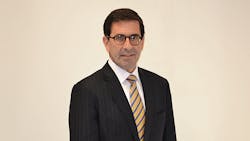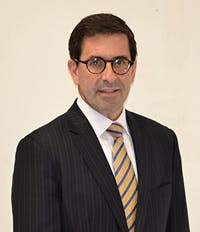Inside Track: Chris Kneizys, President/CEO of Micro-Coax (Part 1)
Download this article in .PDF format
Part 1 of 2. Check out Part 2 here.
CK: Generally, center conductors are either a solid or stranded silver-plated metal wire, which acts as the primary electrical signal carrier for any coaxial cable. (Typically, that wire is copper or copper-clad steel.) Most attenuation occurs at the surface of the center conductor, due to the “skin effect” of microwave signals. This aspect makes the finish or plating more important than the actual wire material. As a result, a more resistive copper alloy can be used for strength and durability without the corresponding higher attenuation (providing the copper alloy is silver plated). Stranded center conductors have slightly higher attenuation than solid conductors. They are generally only used in flexible cable constructions for added flexibility and longer flex life.
JJD: What metals and metallic finishes are used with coaxial cable center conductors?
CK: As flexibility is not a concern, 99% of semi-rigid cables utilize a solid center conductor. Silver-plated copper (SPC) per ASTM B-298 and silver-plated copper-clad steel (also referred to as silver-plated copper weld (SPCW) per ASTM B-501) are the two most common cable center-conductor materials. Silver plating, besides being an excellent electrical conductor, prevents oxidization during manufacture. It improves the solderability of the finished cable as well. Stainless steel and beryllium copper are also used when low thermal conductivity is a priority.
JJD: What are the effects of the materials used as dielectric in coaxial cables?
CK: The insulating material between the center and outer conductor maintains the spacing and geometry of the cable. It also ensures mechanical integrity during forming and bending. A significant portion of transmission losses are caused either directly or indirectly by the dielectric. Cables with a low dielectric constant--while offering lower bulk dielectric losses-- require a larger center-conductor diameter to maintain the same characteristic impedance. The larger center conductor can substantially lower overall cable attenuation.
In addition, the dielectric determines the velocity of propagation, temperature range, power rating, and phase and amplitude stability. It also contributes to cable flexibility. The most commonly used dielectric for microwave cables is polytetrafluoroethylene (PTFE) in full-density, low-density (a.k.a. low loss or micro-porous), and ultra-low-density forms (stretched or expanded PTFE). PTFE is an excellent choice for a cable dielectric due to the following: its low reactivity to chemicals; an operating temperature that can withstand the heat of soldering; and a low dielectric constant that is stable at microwave frequencies. In addition, full-density PTFE meets all the requirements of MIL-DTL-17, Type F-1.
JJD: What is a spline dielectric, and how does it affect coaxial cable performance?
CK: Most semi-rigid cables utilize full-density PTFE in the solid form. However, larger semi-rigid cables are also available in a spline configuration. Spline dielectrics have a thin layer of material around the center conductor with three to five spokes projecting radially outward. The majority of a spline insulator is air, which yields an effective relative dielectric constant as low as 1.3. It should be noted that spline dielectrics, in general, are considerably more expensive than their solid PTFE counterparts.
JJD: What material differences are there between flexible, semi-rigid, and hand-formable coaxial cable?
CK: The materials used for these different types of cable do not vary all that much. Obviously, the construction and longevity of the product depend upon type. For the most part, all three use silver-plated copper center conductors, some form of PTFE dielectric, and a copper-based outer conductor. The primary differences between the three types of cables are the outer conductor and jacket. Semi-rigid cables have a solid copper or aluminum tube with no insulating jacket. This gives semi-rigid cable the advantage of the smallest possible diameter, nearly 100% isolation, and near-“theoretical textbook” attenuation.
JJD: What’s the difference between hand-formable coaxial cables and semi-rigid coaxial cables?
CK: Unlike semi-rigid cable, hand-formable cables can be formed a “limited” number of times without degradation to the cable performance. Instead of a solid tube outer conductor, hand-formable cable utilizes a copper braid soaked in a tin bath. The result is a more pliable cable with the same dimensions as the standard semi-rigid cables, but with slightly higher attenuation. The tin fills in the braid windows, giving hand-formable cables very good isolation. When hand-formable cable is to be used in an application exposed to environmental elements, a fluoropolymer jacket is extruded over the cable to protect it.
JJD: What are the aspects of flexible coaxial cable shields to note?
CK: High-performance, flexible cables typically employ two shields--a helically wrapped silver-plated copper foil and a silver-plated copper braid. The combination of these shields offers outstanding electrical performance and stability along with strength and flexibility. Again, an outer fluoropolymer jacket provides environmental protection.
JJD: How do materials and techniques for strengthening a flexible coaxial cable impact the cable’s performance?
CK: Techniques for strengthening can be applied to the cable design itself or to complementary protection (armoring) layers. In the case of armoring, the goal is usually for the armoring layers to be invisible to the signals that are propagating in the coaxial cable. In some cases, the armor can restrict the cable from mechanical distortions, thereby improving electrical performance in the application.
JJD: How can flexible coaxial cables be strengthened?
CK: There are a number of techniques for strengthening a flexible coaxial cable. The most basic method is to add an armoring. Armoring typically involves a high-strength stainless-steel hose, similar to the old pay-phone cords, or a jacketed stainless-steel spiral. Lately, internal armoring has become more popular. This type of armoring is similar to the other armoring except the strength member is integrated into the cable. It has the advantage of being less bulky.
JJD: Are there coaxial materials that are better or worse suited for automated manufacturing?
CK: To answer your question, absolutely. Material and finish selection can be critical to the assembly or manufacturing methods applied. In most cases, we can enhance manufacturability without trading off electrical performance. For example, we can continue to use a silver-plated copper conductor for the primary cable shield, but select a different alloy or composite for the secondary shield. The secondary shield can then be chosen to optimize the manufacturing method. For example, an alloy could be selected to manage solder wicking or enable the use of compression or crimp fittings.
Equally important is the design of the connectors. Research suggests that as much as 80% of the product cost is committed in the design phase of an assembly. Thus, it should not be a surprise that a coaxial connector that was originally designed for manual solder attachment is not optimum for automation. For high-volume applications, we always prepare ourselves for connector design enhancements.
JJD: What materials and techniques are best suited to qualify semi-rigid coaxial cables for MIL-DTL-17?
CK: The materials used in MIL-DTL-17 cables are strictly controlled by the specification itself. However, the techniques used to manufacture the cable make all the difference and are not controlled by MIL-DTL-17. At Micro-Coax, we draw our own metal tubing and extrude the PTFE dielectric. Over the years, we learned that over-compressing the dielectric with a copper tube that has a die scratch did not survive the heat of soldering. For this reason and others, controlling the raw-material quality is critical to the final cable performance.
About the Author
Jean-Jacques DeLisle
Jean-Jacques graduated from the Rochester Institute of Technology, where he completed his Master of Science in Electrical Engineering. In his studies, Jean-Jacques focused on Control Systems Design, Mixed-Signal IC Design, and RF Design. His research focus was in smart-sensor platform design for RF connector applications for the telecommunications industry. During his research, Jean-Jacques developed a passion for the field of RF/microwaves and expanded his knowledge by doing R&D for the telecommunications industry.

